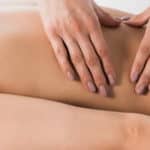Defined as the final menstrual period and usually confirmed when a woman has missed her period for 12 consecutive months, menopause is a natural event. Despite menopause being a normal physiological part of the aging process, its symptoms present a challenge to many women. As one of the predominant symptoms of menopause, hot flashes frequently arise as a massage therapy client’s main complaint. A skilled massage therapist has several bodywork approaches to choose from to offer his or her clients hot flash relief. However, a relatively new study shows that there is another way to help ease hot flashes.
About Menopause and Hot Flashes
Marking the permanent end to fertility, the symptoms of menopause are the direct result of changing estrogen and progesterone levels. The physical signs of menopause begin many years before the final menstrual period. Known as perimenopause, the transition between being fertile and menopause can last six years or more – ending one full year after a woman’s final menstrual period.
While there is great variability in how a woman experiences menopause, those who have early or induced menopause typically experience more prominent symptoms. The most common complaints of perimenopause include:
- Hot flashes
- Irregular menstrual periods
- Sleeping difficulty
- Vaginal dryness
Second only to irregular menstruation, hot flashes occur in an estimated 75 percent of women who go through menopause. Although their exact cause is unknown, hot flashes are believed to be the result of changes in the hypothalamus – the part of the brain that regulates body temperature. If the hypothalamus mistakenly senses that a woman is too warm, it starts a chain of events to cool her down. Blood vessels near the surface of the skin dilate, increasing blood flow to the surface in an attempt to dissipate body heat.
In most instances, a hot flash involves a sensation of head pressure, feelings of heat spreading throughout the upper body and face, flushing with red blotchy skin on the face, neck and upper chest, a rapid heartbeat, perspiration and feeling chilled when the hot flash eases. In addition, some women experience weakness, fatigue and dizziness during a hot flash. Also known as night sweats, nighttime hot flashes are common and wake some women up from a sound sleep to sheets drenched in their own perspiration.
Hot flashes can have a great frequency variance, such as:
- Several per day vs. a few per week
- Persistent sweating day and night vs. occasional feelings of warmth
- Duration of a few minutes vs. half an hour
Women with greater hot flash severity are more than likely to seek help from a conventional or alternative healthcare provider.
Easing Hot Flashes
Because bodywork has the potential to rebalance hormone levels, massage therapists can help their clients through some of the discomforts associated with menopause. The following three massage modalities may help ease hot flashes:
- Swedish Massage – Many studies have found a direct correlation between stress and menopausal symptom severity. Since Swedish massage is extremely conducive to relieving stress, it also can minimize menopausal symptoms.
- Foot Reflexology – Utilizing pressure points on the foot that correlate with the internal organs, this modality may help balance the hormones. Experts suggest areas that correspond with the kidney, adrenals, pituitary, brain, uterus, thyroid, heart and liver for this purpose.
- Shiatsu – Regarded as the natural decline in Kidney and Spleen energies, shiatsu tonification techniques on these meridians can help restore hormonal balance.
In addition, massage therapists who can help guide their clients to mindfulness-based stress reduction (MBSR) have another method to help clients with hot flashes. A new study published in a 2011 edition of Menopause: The Journal of the North American Menopause Society shows that women who used mindfulness-based stress reduction were less bothered by their hot flashes even though their intensity did not change.
MBSR for Hot Flashes
MBSR uses mindfulness meditation to teach people how to take better care of themselves and live healthier and more adaptive lives. Mindfulness is as simple (and as difficult) as living in moment-to-moment awareness. MBSR typically includes training in meditation, mindful yoga and relaxation techniques.
Researchers from the University of Massachusetts Medical School found that women who learned MBSR reduced the degree to which they were bothered by hot flashes:
- Immediately after MBSR training, women who used the technique experienced a 15 percent reduction in bother caused by their hot flashes compared with a seven percent reduction in the no-training group.
- Twenty-two percent were less bothered for up to three months after training compared with an 11 percent reduction among the comparison group.
According to study researcher James Francis Carmody, PhD, “Mindfulness training involves women learning to recognize and discriminate more accurately between the components of experience such as thoughts, feelings and sensations and developing a nonreactive awareness of these components.” The researchers added that mindfulness creates a psychological distance allowing the person to observe, appraise and be less reactive to events occurring internally or in their environment.
When seeing female clients in their late 40s and 50s, hot flashes are likely to be a dominant health complaint. Working with massage techniques that induce relaxation and help balance hormonal levels can benefit menopausal clients, but learning more about mindfulness-based stress reduction can prove to be a valuable addition to a practitioner’s menopausal repertoire.
Recommended Study:
Reflexology
Shiatsu Anma Therapy
Swedish Massage for Professionals















